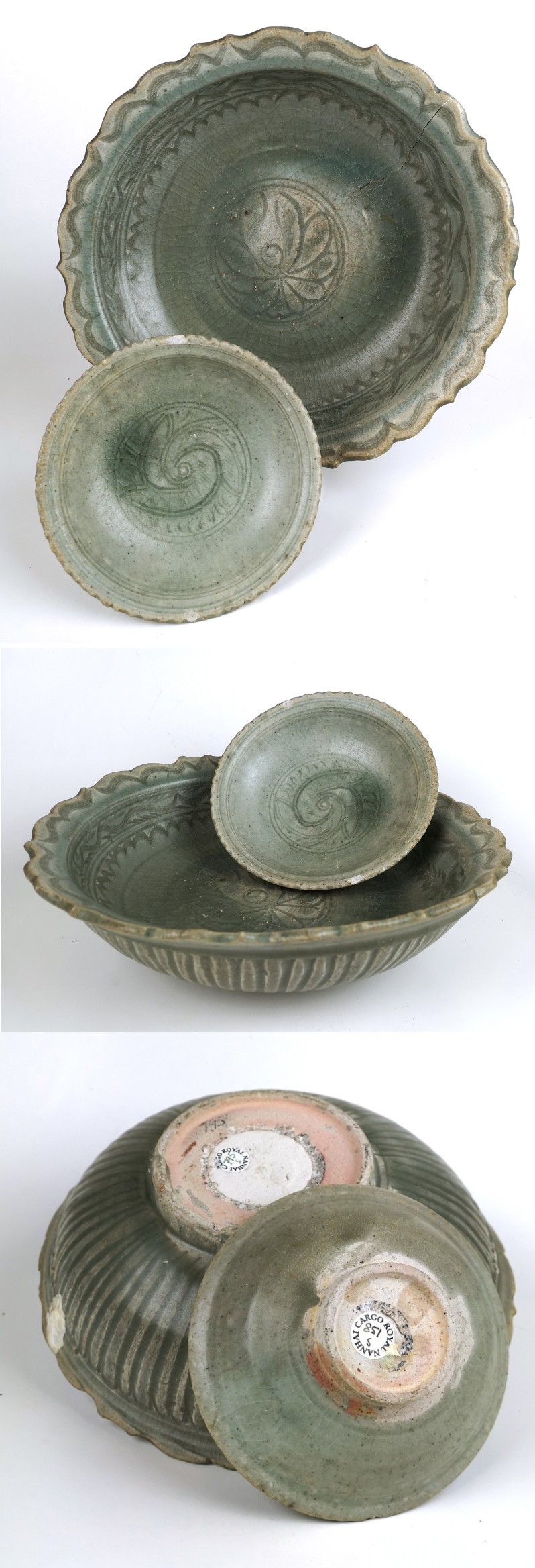
Thai, Si-Satchanalai (Sawankhalok) from the Royal Nanhai cargo. The recovered cargo from the Royal Nanhai included 20,973 pieces of green and brown glazed Celadon ceramic. The largest portion was small celadon jarlets and bowls in various shapes from the Si-Satchanalai (Sawankhalok) kilns. A small number was large dishes, some with carved decoration. Only about a fifth of the ceramic cargo was in fair condition, the majority having been much deteriorated, partly from the long submersion.
The Royal Nanhai was a Siamese junk wreck discovered at a depth of 46 meters, 40 nautical miles from the coast of Kuantan, West Malaysia.
The recovered cargo from the Royal Nanhai included 20,973 pieces of green and brown glazed Celadon ceramic. The largest portion was celadon in various shapes from the Si-Satchanalai (Sawankhalok) kilns. Only about a fifth of the ceramic cargo was in fair condition, the majority having been much deteriorated, partly from the long submersion.
Samantha black-glazed storage jars were also found, a number of which contained the remains of fish bones from a salt-water mackerel still considered a delicacy in Southeast Asia.
The most important find was that of a hidden compartment located between the lower decking and keel, containing a cache of artifacts including seven pieces of blue and white Chinese porcelain, a finely detailed bronze seal that could be linked to the ruler of the Majapahit kingdom, a lacquer-ware box and an ivory sword handle. The presence of the seal suggests the possibility of this ship being on a diplomatic mission, and that this secret collection of valuables might have been intended as a royal gift to an neighboring ally.
Voyage
The destination might from available data have been the southern port of Tuban in Eastern Java. The reason for the disaster to strike this vessel was likely to be one of the violent monsoon storms common to the South China Sea.
Ship
Her unusual length and extremely heavy load may have contributed to her difficulties, causing her to sink.
Discovery
The ship was rediscovered in 1992, about 550 years after the accident by the marine salvage expert Sten Sjöstrand who named the ship the Royal Nanhai in honour of the 15th century Chinese name for the South China Sea - Nanhai.
Excavation
Four years of excavations were completed in September 1998.Dating
It is the blue and white porcelain that has helped to date the wreck and its contents most accurately, suggesting a date for the wreck of mid-15th century, supported by a carbon-14 date corresponding to AD.1400 +/- 70-years.
Donations
Of the recoverable twenty percent, 2,619 pieces were donated to the National Museum in Kuala Lumpur where they will be available for future study. Another representative selection was given to the Pekan Museum in Pahang State and the Malacca Museum Corporation.
Their unquestionable authenticity and precise dating provide a level of provenance that is rarely seen today in the Southeast Asian antique pottery market, and several international museums, including the Victoria & Albert Museum in London, now display pieces from the Royal Nanhai Cargo as reference material.
Remaining pieces of what could be recovered have been made available for sale, allowing some of the finest 15th century celadon wares ever seen to become available to private collectors and institutions alike.
A